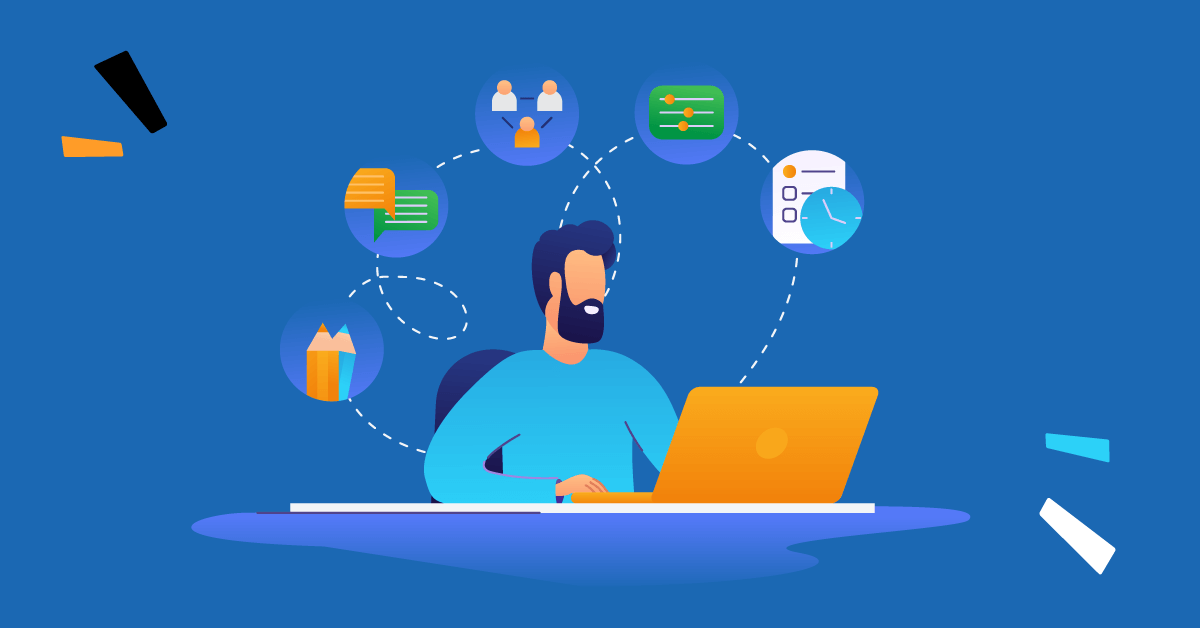Sometimes small can be very powerful.
Tech developments and innovations have enabled the world to achieve results by using more efficient means. For example, tiny surgical cuts, smaller but better devices like earbuds instead of headphones, etc. Mobile phones, for instance, were once as big as a purse, and could only be used for calls, but now they’re as small as one’s palm, plus offering more possibilities in people’s daily lives (networking, taking photos/videos, listening to music, and more.)
Learning hasn’t fallen behind this “shrinking” effect. Employee training has been shaped to better fit tight work schedules and digital transformation.
In today’s work environment, where continuous learning is encouraged, watching hours of monotonous, long training videos can be hard. But what if people could receive tiny bits of useful information in a more entertaining and engaging way?
Newer generations prefer shorter training bits on social media platforms (TikTok, YouTube, Instagram) to textbooks or other training materials. According to Google’s report, YouTube #shorts have gained amazing popularity among viewers. Quick training content provides people with all the valuable information they need in a way that grabs their attention in seconds or minutes.
This emerging trend is nanolearning–a way of delivering condensed information in a highly engaging format. Through platforms like Tik Tok, Twitter, or Instagram, soundbites, videos, or sentences provide all the valuable and relevant information learners need.

What is nanolearning?
Nanolearning is a bite-sized training course, shorter than microlearning.
Very small, bite-sized learning experiences can be completed in a shorter time than more traditional learning experiences. Nanolearning training modules are designed to be accessible and digestible so as to deliver content quickly and efficiently.
For example, a nanolearning course could be a small video tutorial or an infographic that gives insights on a specific skill or topic in seconds or a few minutes. Imagine a short video showing how to use a software application or an infographic providing cybersecurity tips (a rather complex topic) in a simplified way.
Nanolearning has the ability to grab learners’ attention anytime, anywhere, in a split second and deliver the training content very effectively. Also, it leaves learners with a desire to return for more similar content.
Let’s better understand what nanolearning is and how it works with a short (no pun intended!) example.
Mike is a busy HR executive. His boss asked for a report on the training sessions the company has delivered during the past six months. Mike knows that he can get this report through his LMS—after all, he watched a webinar about all the features of the platform when he originally created an account. But since he hasn’t checked reports since then, it’s difficult for him to remember how to export them. Instead of going back to the webinar and trying to find the part that describes reports, he can have a look at an infographic made specifically for this feature. In just a few seconds, he’ll know where he needs to click to download and share the report.
This infographic is a perfect example of nanolearning content. People can consume content any time during their day, while taking a break, or during their commute. And it’s very effective for refreshing knowledge—as Mike did.
Facilitate employee training with targeted content
Create nanolearning sessions with TalentLMS.
The training platform that users consistently rank #1.
Nanolearning vs. microlearning
A common misconception is that nanolearning and microlearning are the exact same thing.
Even if they’re quite similar, as they both deliver meaningful training content in a fast manner, they differ in some parts.
They both:
- Facilitate learning reinforcement
- Assist with self-paced learning
- Offer low-cost training
- Focus on learning objectives
- Provide knowledge at the moment of need
- Use various media outlets
- Reduce cognitive load and fatigue
- Allow for easy access anytime, anywhere
But the main difference between them is the duration of learning. An average microlearning module lasts 10-30 minutes, while nanolearning modules last 2-5 minutes. Think about this—multiple nanolearning sessions can create a microlearning course.
Let’s say a refresher compliance training session can be delivered in a 20-minute microlearning video or delivered through cards on learners’ devices in 5 minutes.
Also, microlearning, as it’s longer in duration, can provide information in greater detail, while nanolearning can be used to briefly go over the core points of the training content.
Benefits of nanolearning
Nanolearning, a bite-sized learning approach, has gained popularity among organizations that are looking to train their people on specific skills or provide knowledge quickly and effectively.
So, which are the main benefits nanolearning offers to organizations? Nanolearning:
- Increases engagement and retention: Learners can focus on one thing at a time, being able to better concentrate and retain information.
- Enhances flexibility: Nanolearning can be provided by using different formats, like videos, podcasts, cards, quizzes, infographics, or text. As a result, it caters to different learning styles.
- Provides convenience: People can access nanolearning modules anytime, anywhere, making it very convenient for employees with busy schedules or remote/hybrid workers.
- Is budget-friendly: Nanolearning is more cost-effective than other, more traditional forms of training (conferences, webinars, ILT sessions)
- Offers gamified learning: Gamification elements can be included in nanolearning modules, making training more interactive, fun, and engaging.
Exploring nanolearning use cases: How to implement it in your L&D strategy
As we’ve explored, nanolearning is a great way to rapid skill development that can benefit your teams and set them up for success.
But how can nanolearning fit into a company’s L&D strategy?
Workplace training for reinforcement
Your workplace training strategy shouldn’t neglect on-the-job reinforcement and supplementary training. They’re essential for keeping your people aligned and up-to-date on product training, skills development, cybersecurity training, and more.
With the help of nanolearning training modules, it’s possible to further increase employee engagement while improving their knowledge retention in a cost-effective and efficient way.
Instead of providing overwhelming training content with a nanolearning strategy at hand, training is focused on the key elements of a topic without causing cognitive overload to your people.
Employees can freshen up their knowledge by easily storing the information in their long-term memory.
Simultaneously, nanolearning courses let your employees control their learning experience, unlike traditional training courses. They can access training anytime and anywhere, making it less time-consuming and overwhelming.
For example, you can assign small quizzes to your employees on specific topics to boost memory retention and reinforce key information after a more traditional, lengthy training session on a complex subject like cybersecurity.
Self-improvement topics
Create an appetite for learning by including nanolearning modules in training sessions that are focused on general and self-improvement topics, such as mindfulness, healthy habits, etc.
More and more companies have taken into consideration the need for people to develop healthier habits to cope with the fast-paced changes of the modern world. As such, they have introduced training modules on self-improvement and personal development.
These topics can be rather challenging, and people need regular reminders to follow tips, retain information, and put them into practice daily.
Nanolearning is a great way to assist people who participate in self-improvement training. For example, HR can send weekly emails, including infographics with tips and useful facts around mental health, maintaining a healthy lifestyle, etc., as reminders. Or, provide ready-made videos from a pre-built content library in their LMS that go over these topics in an interactive and engaging way.
Meet TalentLibrary™
A growing collection of ready-made courses that cover the soft skills
your teams need for success at work
![]()

Employee upskilling/reskilling
Upskilling and reskilling allow organizations to avoid a long hiring cycle. At the same time, employees are well-equipped to perform their jobs.
Nanolearning enhances an organization’s upskilling and reskilling strategy, as it offers supplementary, more personalized learning opportunities that drive engagement.
For instance, provide your teams with skill-specific nanolearning video modules after a job shadowing or coaching session to help them better retain the core elements being covered. Or, combine nanolearning with game-like activities and leaderboards to boost friendly competition, motivating learners to perform their best during training. In fact, 83% of those who receive gamified training feel motivated, according to a TalentLMS survey on gamification.
Quick tips for customers
Customer training and insights for processes, products, and services can sometimes consume effort, time, and resources.
Organizations could opt for budget-friendly ways of offering tips to clients and customers. One way to achieve this is by offering nanolearning modules to customers.
Customers can access nanolearning content wherever and whenever they want. They can gain valuable information about what they’re looking for, in a cost-effective way, through quizzes, ready-made videos, or even plain text. Or benefit from in-app nanolearning content. For example, while customers use a digital platform, popups with extra tips appear on the screen, giving them more information about what they need.
As a result, the customer experience enhances, and happy, informed customers are more likely to stick with your organization for longer.
Challenges: When not to use nanolearning
Even if nanolearning is an amazing way to boost an organization’s L&D strategy, it’s not the best fit for all needs.
There are certain limitations businesses should consider before using nanolearning and discover how to overcome them or avoid them if necessary.
Limited content value
Nanolearning focuses on building and enhancing rapidly specific skills and knowledge. It’s not possible to delve into deeper knowledge through nanolearning modules. In cases more comprehensive training is needed, nanolearning can’t help.
Tip: Use nanolearning modules as a supplementary form of extended training or as refreshers that follow it, and not as a core training session.
Questionable knowledge retention
Sometimes the format of nanolearning can be really short, i.e., under 2 minutes of video.
Certain employees might have difficulty remembering the information they received in such a short period of time. Or, they might not be able to fully process and integrate the information of the nanolearning bit.
Tip: Depending on the training topic, focus on using only the key points you need your nanolearning content to include. Don’t bombard learners with a lot of information in only one nanolearning module. Instead, produce a couple of brief and very clear bits and offer them to your teams daily/weekly/monthly according to their needs.
Little peer interaction
Asynchronous, self-paced training modules, like nanolearning, don’t support face-to-face or peer interaction. This can sometimes lead to social isolation, anxiety, and even proximity bias.
People, especially remote teams, greatly benefit from occasional online group training, as they have the opportunity to socialize, exchange ideas, and develop stronger interpersonal skills.
Tip: Make nanolearning a group activity for your teams. For example, you can create two training groups, have each complete a nanolearning module, and then compare their results in a discussion board or an (online) group meeting.
Encourage peer learning with TalentLMS
Schedule group training meetings and build discussion forums.
Easy to set up, easy to use, easy to customize.
Not applicable on certain training topics
Unfortunately, nanolearning can’t be applied to all disciplines and topics. For instance, there are cases where employees need more hands-on experience than theory (i.e., customer service calls).
Or in manufacturing businesses, employees must undergo special training for handling equipment, machines, etc. This knowledge is hard to deliver through nanolearning, and knowledge retention must be ensured.
Tip: Use nanolearning as complementary training. Allow your employees to revise knowledge they have learned in their hands-on training sessions by providing nanolearning modules that cover the fundamentals of the theory behind training or key points they need to refresh.
The future of nanolearning
The ultimate goal of nanolearning is to assist people in learning new things faster and more efficiently than before without them having to dedicate a lot of time, effort, or attention to a single topic.
As new technologies continuously emerge, like AI, nanolearning will also evolve, impacting training and allowing for more flexible, just-in-time learning that eliminates cognitive overload.
Forget about “go big, or go home”! “Good things come in small packages,” they say, after all…
| Tags: Employee Training,Microlearning



